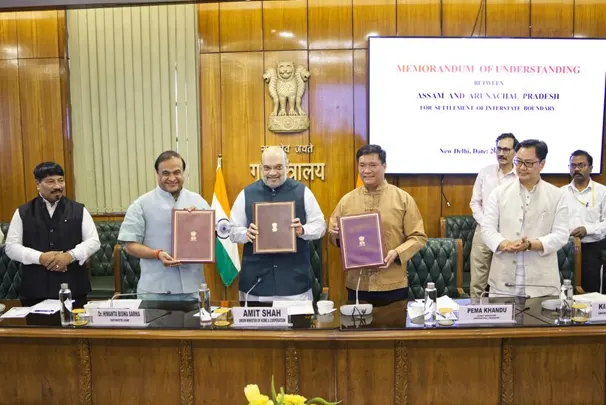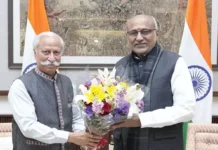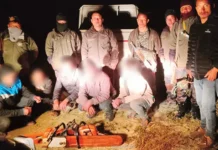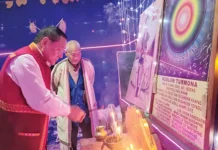[Amar Sangno]
ITANAGAR, 21 Apr: In a historic development, the governments of Assam and Arunachal Pradesh inked a memorandum of understanding (MoU) on Thursday to settle the interstate boundary issue between the two states.
The MoU was executed by Assam Chief Minister Himanta Biswa Sarma and Arunachal Chief Minister Pema Khandu, in the presence of union Home Minister Amit Shah and union Law Minister Kiren Rijiju, in New Delhi.
The local commission report of 2007 had identified boundary issues in 123 villages. The two state governments have agreed that the MoU shall be the full and final agreement with respect to 123 villages and no new claim area and village shall be added in the future beyond the already claimed 123 villages.
Both states have agreed that the remaining unresolved boundary issues will be finalised through a continuous dialogue process by the regional committees within six months.
With regard to Kamengbari village, which falls under West Kameng and Sonitpur (Assam) districts, both states agreed that the total area of approximately 7.0 sq kms will be included in Arunachal from the Sonai Rupai Wildlife Sanctuary (erstwhile Charduar reserve forest).
With regard to Bhalukpong, the boundary line will run along the notified boundary line of BP-130 towards Dolsiri Nallah, thence turn towards Deputa in the northeastern side along the notified boundary connecting BP-6/1 at Deputa and further to BP-7/1 behind the Assam Tourist Lodge, Bhalukpong (Prashanti Lodge).
Four villages – Dipik, Baliso, Passo and Dikalmukh – will be included in Arunachal from the erstwhile Rehali reserve forest in Pakke-Kessang-Biswanath.
The area of Passo village beyond 3 kms from the interstate boundary (approximately 2.598 sq kms) is to be included in Arunachal, in exchange for inclusion of an equal area from Dirring in Arunachal to Assam, it added.
The MoU stated that the remaining unresolved boundary areas beyond Dikalmukh and near the trijunction of Pakke-Kessang, Papum Pare and Biswanath districts, involving the Radasso river, will be finalised by the regional committees through continuous dialogue within a period of six months.
The unresolved boundaries of the villages situated in Biswanath and Lakhimpur areas of Assam under Papum Pare Biswanath/Lakhimpur regional committees will be finalised by both the regional committees, including identification of the uninhabited land for exchange in lieu of the villages beyond 3 kms from the HPTC line inside Assam, and vice versa, through continuous dialogue.
In Kamle-Lakhimpur district, the villages situated fully or partially outside the IAF bombing area will be included in Arunachal and the unresolved boundaries will be finalised through continuous dialogue by the regional committees within a timeframe.
The matter relating to Midpu, Kherbari and Rajali villages, which are partially situated inside the IAF bombing area, will be taken up by Arunachal with the government of India and the Indian Air Force (IAF). The IAF will have unhindered right to use the entire bombing range, it added.
Both the states have mutually agreed to realign the boundary of four villages – Telam, Telam Camp, New Deka and Potte – along the existing railway track from the Dikhari river in the east to the Seren/Agma river in the west, where the north of the track would lie inside Arunachal and the south of the track would lie inside Assam in Lower Siang-Dhemaji districts.
Three villages – Aditako, Mingrnang and Ruti – will remain with Assam, as the villages are surrounded by people of Assam from all sides, and also the villages are beyond the 3-km line inside Assam from the interstate boundary, it stated.
Both the states agreed that Balisori (approximately 1.7 sq kms), which was to remain in Arunachal as per the Namsai Declaration, and other areas situated along the interstate boundary inside Arunachal but occupied by the people of Assam, will be included in Assam on an ‘as is where is’ basis, as per the map prepared, exchanged and mutually agreed between the regional committees.
Six villages – New Mingrnang, Hime, New Hime, Germe, Rate and Siloni Adi – are to be realigned suitably, segregating the habitations of the people of Arunachal and the Assamese population, as per the map prepared, exchanged, and mutually agreed between the regional committees.
Torajan Adi village will be included in Arunachal with additional 209 bighas (approximately 28 hectares) of agricultural land. Hime village, with agricultural land contiguous to the homestead, and in possession of Arunachalee people, will be included in Arunachal as per the map prepared, exchanged and mutually agreed between the regional committees.
In Lower Dibang Valley-Tinsukia, out of total six villages, both the states agreed on two villages – Keba and Banggo – to be included in Arunachal. Two villages – Kaling-I and Kaling-I – will be partly in Assam and partly in Arunachal.
Both the states agreed to include Paglam village in Arunachal and adjust the area situated beyond 3 kms inside Assam from the interstate boundary, with the area of Kaling-I and Kaling-II villages and the area occupied by the people of Assam inside Arunachal.
Just after signing the MoU, Khandu tweeted, “With blessings of honourable Prime Minister Narendra Modi Ji, Arunachal Pradesh and Assam today signed an Agreement for settlement of long-pending inter-state boundary issue between the two states.”
Khandu added that “the momentous occasion will ensure sustained, lasting peace and spur our shared growth and overall prosperity in the Northeast.”
Khandu also expressed appreciation for Prime Minister Narendra Modi and union Home Minister Amit Shah “for guiding in resolving the more than five decades old border issue between the two states.”
He also acknowledged his Assam counterpart “for his role and exceptional leadership and cooperation in resolving the boundary issue.”
Sarma also remarked, “After 51 years, one of India’s longest running interstate dispute comes to a decisive end. This breakthrough has been possible due to Hon’ble Prime Minister Narendra Modiji blessing, guidance of Home Minister Amit Shahji and unstinted support from Chief Minister Pema Khanduji.”
“This will boost the spirit of bonhomie in the Northeast and strengthen our federal structures as it brings a new paradigm to resolve differences between states,” Sarma said.
The regional committees appointed by both the state governments carried out rigorous field visits, inspections and coordination meetings on several occasions and, after a thorough examination of the matter in hand, submitted their findings and recommendations in joint reports.




